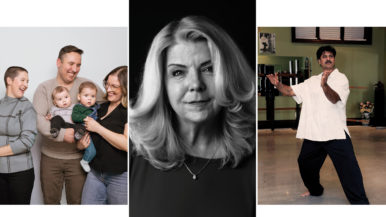Vieux Télégraphe, Single Serve Stone Cellars
When the stakes are high, you gotta know when to hold ’em. An urbane, mild-mannered French winemaker named Daniel Brunier made two Toronto appearances late last week showcasing two family wineries from the Chateauneuf-du-Pape appellation in the south of France: the renowned Domaine Le Vieux Télégraphe, plus a newer, refurbished estate called Clos La Roquete. The most famed appellation of the southern Rhone is home to the world’s best known, most powerful and long-lived grenache-based reds, usually blended with syrah, mourvedre and other grapes—up to 22 are allowed. Although some Chateauneufs are robust and round enough to enjoy when young, others from top estates have considerable longevity.
Brunier’s audiences included city sommeliers gathered by importer Andrew Hanna), at Jamie Kennedy Wine Bar, then a cadre of collectors who store their cellars at the Fine Wine Reserve. A multi-vintage vertical of Le Vieux-Telegraphe (named for the line of old telegraph poles that run through the property) was poured at both locations, with most discussion focusing on the differences between the classic, highly structured Vieux Télégraphe 2004 ****1/2 ($50, 2007 release) and softer, richer very flattering Vieux Télégraphe 2003 **** ($49.95, Vintages Sept 2006). I preferred the former, as did most collectors who look to the future to enjoy their wines. The 2004 is dense, complex and tight with classic plum, pepper, meaty nuances and a slap of licorice on the finish that is real marker for the southern Rhone. Brunier likened the 2004 to the Vieux Télégraphe 1999, also poured alongside, a sensory barrage with haunting length and finesse. The sommeliers preferred the hot vintage 2003, with its very ripe, sweet brambleberry, almost zinfandel-like fruit, and initially smooth, dense mouth feel that actually masks some quite substantial tannin. There is of course no right or wrong answer, but if drinking an expression of place is the objective, one goes with the proprietor who lives on the place, and picks the 2004. If the objective is to please people dining in the moment, the 2003 is the way to go. All of which makes the study of the differences not only fun, but necessary, especially with more expensive, higher risk wines.
My rankings and best drinking prognosis for the vintages poured are as follows:
- Vieux Télégraphe 2004 ****1/2 2009 to 2017
- Vieux Télégraphe 2003 **** 2007 to 2012
- Vieux Télégraphe 2001 ***** now to 2020
- Vieux Télégraphe 2000 **** now to 2011
- Vieux Télégraphe 1999 ***** now to 2012
- Vieux Télégraphe 1998 ****1/2 now to 2010
- Vieux Télégraphe 1994 ***** now to 2015
- Vieux Télégraphe 1989 **** now to 2009
From these heights we return to Earth to talk about the alternative packaging concepts now chewing up shelf space at the LCBO. Must be hard times out there, with a desperation to find new customers by making wine easier, more convenient and fun. All a good thing, when the contents measure up. And not a good thing when alt-packaging continues to broadcast the message that the quality of anything in a non-traditional package is poor. Which is the case of the latest arrival—unbreakable (plastic) single serve screwcap bottles— from Beringer’s Stone Cellars in California. Despite being called “premium” wines in the press materials these contents don’t measure up. The California appellation, non-vintage dated, 187 ml bottles are sold in four-packs, adding up to the same portion and price as a regular 750ml bottle. Stone Cellar Pinot Grigio *1/2 ($13.95/4x187ml, LCBO) smells of its plastic container, has very little fruit but is well balanced. Stone Cellars Cabernet Sauvignon **1/2 ($13.95/4x187ml, LCBO) is better, with hints of cab character (celery/tobacco) amid indistinctive berry-grapy fruit. Beringer White Zinfandel ** ($10.95/2x187ml, LCBO) is candied sweet with raspberry tea flavours.





